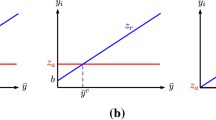Abstract
This paper presents three different poverty standards. A first approach takes the disposable income as an indicator of poverty. A second approach uses the Leyden approach. Finally an aggregate index of deprivation, based on the observation of consumption events, is constructed through a particular econometric procedure proposed by Desai and Shah (1988). These alternative measures are then compared on a sample composed of 6380 Belgian households. Such an analysis can be expected to provide some further insight into the problem of measuring poverty, which has been the subject of a recent controversial debate.
Similar content being viewed by others
References
Deleeck H, Cantillon B, de Lathouwer L, Van den Bosch K, Wyns M (1986) Indicateurs de la sécurité sociale 1976–1985. Rev Bel Sec Soc, Annexe au no 4–5
Deleeck H, Van den Bosch K (1990) The measurement of poverty in a comparative context: Empirical evidence and methodological evaluation of four poverty lines in seven EC countries. In: Teekens R, Van Praag BMS (eds) Analysing poverty in the European Community, policy issues, research options and data sources. Eurostat, Luxembourg
Desai M, Shah A (1988) An econometric approach to the measurement of poverty. Oxford Econ Pap 40:505–522
Flik R, Van Praag B (1991) Subjective poverty line definitions. Economist 139(3):311–330
Goedhart T, Halberstadt V, Kapteyn A, Van Praag B (1977) The poverty line: concept and measurement. J Hum Resources 12:503–520
Hagenaars A (ed) (1986) The perception of poverty. North-Holland, Amsterdam
Hagenaars A, De Vos K (1988) The definition and measurement of poverty. J Hum Resources 23:139–153
Modigliani F, Brumberg R (1954) Utility analysis and the consumption function: an interpretation of cross-section data. In: Kurihara K (ed) Post-Keynesian economics. Rutgers University Press, New Brunswick
OECD (1989) National Accounts, Volume I. Paris
Townsend P (1979) Poverty in the United Kingdom. Penguin, London
Townsend P, Gordon D (1989) What is enough? New evidence allowing the definition of a minimum benefit. Conference on “Income and Material Well Being”, Luxembourg Income Study. Luxembourg, July 9–12 1989
Van Praag B (1971) The welfare function of income in Belgium: an empirical investigation. Eur Econ Rev 2:337–369
Van Praag B, Van der Sar N (1988) Empirical uses of subjective measures of well-being: household cost functions and equivalence scales. J Hum Resources 23:193–210
Zellner A (1963) Estimators for seemingly unrelated regressions equations: some exact finite sample results. J Am Stat Assoc 48:977–992
Author information
Authors and Affiliations
Additional information
We thank the participants of the Second Annual Meeting of the European Society for Population Economics, June 23–25, 1988, Mannheim (FRG), L. Gevers, J. Lindsey, P. Pestieau, B. Sak, K. Van den Bosch and two anonymous referees for their comments and suggestions.
Rights and permissions
About this article
Cite this article
Delhausse, B., Luttgens, A. & Perelman, S. Comparing measures of poverty and relative deprivation. J Popul Econ 6, 83–102 (1993). https://doi.org/10.1007/BF00164340
Received:
Accepted:
Issue Date:
DOI: https://doi.org/10.1007/BF00164340




